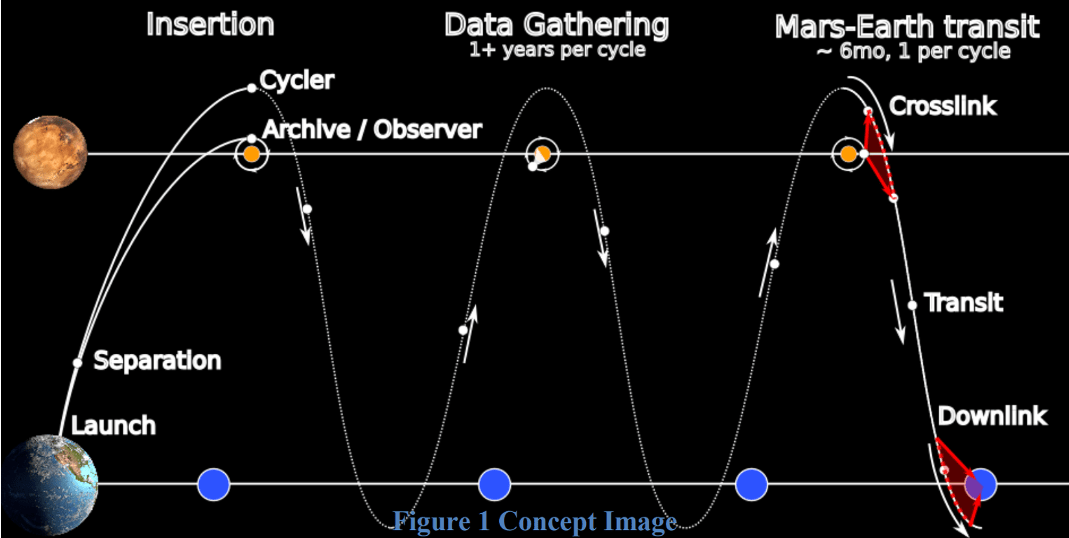Getting data in from deep space can be difficult. Almost all of our missions that have flown into deep space use the Deep Space Network, a system of transmitters and receivers that already imposes constraints on the amount of data we can transfer from the far reaches of space. So a team led by Joshua Vander Hook, then at NASA’s Jet Propulsion Laboratory and now at a start-up called Outrider.ai, came up with a way to dramatically enhance the throughput of the DSN. In so doing, they gave it a very catchy name – the Solar System Pony Express.
Dr. Vander Hook was initially supported by a NASA Institute for Advanced Concepts (NIAC) grant in 2021. The basic concept utilizes what is known as a “cycler” orbit, where a spacecraft repeatedly orbits between two bodies in the solar system using their gravity wells to swing around in sync with when their orbits pass each other.
In this case, the spacecraft would consist of a communications relay module that would collect high-throughput data from an observer module parked in orbit around the other body. The observer module would consistently download data from the missions operating in its local area and then, when a relay module gets close, would rapidly send all of that data to the cycling spacecraft. The cycler then returns to Earth, where another rapid download process begins, and the cycle repeats itself.
That sounds like the Pony Express – a system in the 1800s whereby mail carriers would ride physical ponies (or horses) to deliver mail occasionally to remote outposts in the American West. In another homage to that mail carrier heritage, the team named the cycling relay satellites “data mules.”
Those data mules would have a long trip between Earth and their target destination. It might come as no surprise that in much of the literature surrounding the idea that the target destination was Mars. Buzz Aldrin, the most famous proponent of cycler orbits, suggested that cycler “castles” could effectively shuttle people and goods between Mars and Earth. But in this new configuration, instead of physical things, it would be more beneficial to ship data.

Credit – Marc Sanchez-Net et al.
Calculations described in a paper released last year estimate that with as little as six data mules, the network could provide a bandwidth of 1 petabyte a year from the surface of Mars while only requiring a minor allocation of time on the DSN. That would potentially allow some real-time high-definition video from the red planet, which would undoubtedly be attractive to many of the inhabitants of its nearest neighbor.
However, such high data rates come at a cost. In the case of the Solar System Pony Express, that cost is latency. The high throughput data transfer possible between the observer and a data mule, and then again from the data mule back to a receiving station on Earth, is only possible if they are in physical proximity to each other, as the network would use a type of high-throughput optical communications network. And since cycler orbits can take years, it would be years after the data was collected on the red planet that anyone could use it.
That is not a show stopper – indeed, many people would be okay with waiting for over a year for a high-definition video from Mars if that is the only way for them to see it. But it makes funding such a mission more difficult given the immediate feedback culture prevalent in many of today’s media. Give the authors credit, though – they recognize this limitation and, as all good scientists do, mention that it would be a good topic for further study.
For right now, that further study seems to be on hold. Dr. Vander Hook has moved on to other non-space-related efforts. While there has been some interest from researchers elsewhere, such as a paper from the University of Illinois, there’s currently no clear path forward for the project. But, there will always be a desire for more data transfer from farther out in the solar system. If the Pony Express is the most cost-effective way to get it at the beginning of our explorations, then don’t be surprised if this concept is resurrected sometime in the future.
Learn More:
Pascarella et al – Low-thrust trajectory optimization for the solar system pony express
Sanchez Net et al – Cycler Orbits and Solar System Pony Express
UT – NASA has too Many Spacecraft to Communicate With. Time to Build More Dishes
UT – We’re Entering a New Age When Spacecraft Communicate With Lasers
Lead Image:
Artist’s depiction of a representative cycler orbit.
Credit – Joshua Vander Hook

